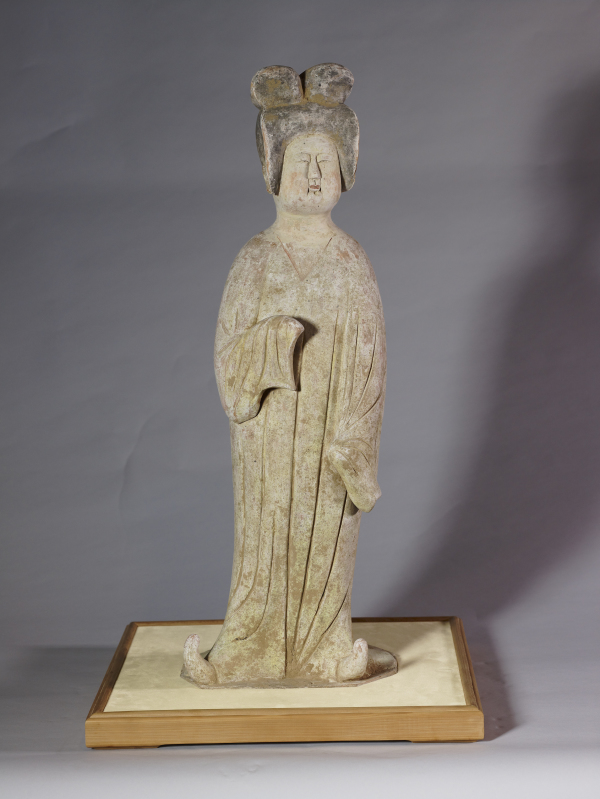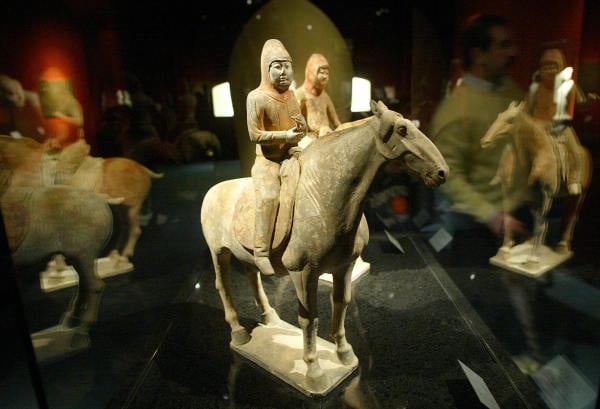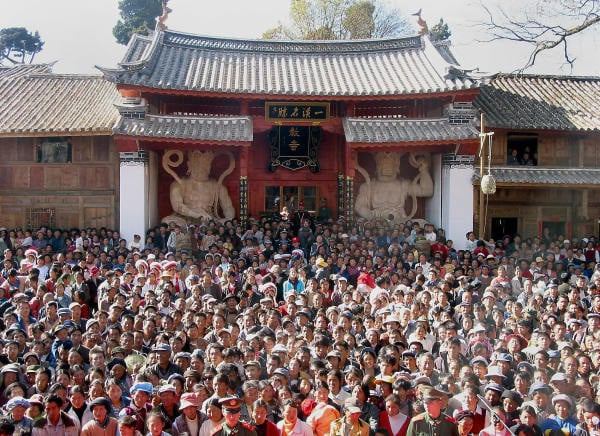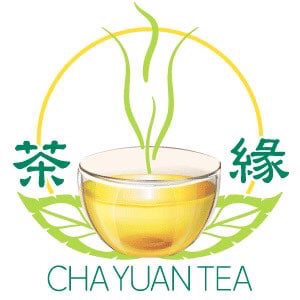
[ad_1]
Lady of Tang DynastyThe plump beauty. (Image source: public domain)
Aesthetics anddietIt can often truly reflect the appearance of an era.Tang DynastyThe author does not need to say more about the prosperity of culture, economy and other aspects; in the 7th century ADTang DynastyAt its peak, the national territory covered an area of 12.37 million square kilometers, including the Central Asian oasis zone at that time; it extended to Luovu Prefecture (now Ha Tinh, Vietnam) in the south, Xuanque Prefecture (now the Angara River Basin in Russia) in the north, and to the west The vast territory of Jilingfu (today’s Zabol, Iran) and Jilinzhou (today’s Gyeongju, South Korea) to the east.
The “Gray Pottery and Colorful Lady Figurines” (AD 618-907) currently stored in the National Palace Museum in Taiwan allow future generations to appreciate the plump beauty of ladies in the Tang Dynasty: their eyebrows and eyes are very slender, with small cherry mouths, looking relaxed and graceful. , happy and confident.

The “Gray Pottery and Colorful Lady Figurines” collected in the National Palace Museum in Taiwan. (Image source: Public Domain National Palace Museum, Taiwan)
In an era without fried chicken, French fries, and Coke, it was impossible to achieve a giant baby figure. Of course, based on today’s aesthetic standards, it would be difficult for a woman with such a figure to be confident. However, what is interesting is what exactly was eaten on the dining table of the Tang people more than a thousand years ago? It must be very rich, and what are its eating habits?
staple food
During the Qin and Han Dynasties, people only ate two meals a day. During the Han Dynasty, Zhang Qian passed through the Western Regions, and food from the Western Regions was also introduced to the Central Plains, such as watermelon, Hami melon (Hami City, Xinjiang), grapes, courgettes, peppers, and Hu cakes.
In the Tang Dynasty, people already had three meals a day, breakfast, lunch and dinner, mainly pasta. Eat porridge or cakes for breakfast. Common cakes include Hu cakes and steamed cakes. Hu cakes are a type of pastry introduced from the Western Regions, including vegetarian cakes, oil cakes, meat cakes and sesame cakes.
For lunch, rice, wheat, millet, millet, and wild rice can all be called rice. Dinner is soup or pancakes.
Soup cake refers to “fufu”, which is an ancient Turkic transliteration and was introduced to the Central Plains during the Wei, Jin, Southern and Northern Dynasties. Knead the unleavened dough and roll it into strips, then cut it into half-finger-long pieces. Volume 2 of “Guitian Lu” by Ouyang Xiu of the Song Dynasty records: “Tang Cake was called Bu Tuo by the Tang Dynasty, but today it is called Fu Fu by the common people.” “Yan Fan Lu Bu Tuo” by Cheng Dachang of the Song Dynasty recorded: “Tang Cake is called Fu Fu. , also known as Bu Tuo… Bu Tuo means not holding the words in the palm of your hand.”
The book was written in June of the 10th year of Dazhong Dynasty. It is recorded in the “Shan Fu Jing Shu Lu” written by Yang Ye, the magistrate of Tangchao County on the right: “There are thin and thin grains, long belts and square leaves. , there are thick and cut ones, side porridge ones, gluten-cut porridge, porridge with porridge and musk porridge. , There are many names for people who split porridge, but they are all like “Bufu”. There is also the case where mutton is cooked into a bowl, covered with “Bufu”, enriched with five-flavor juice, and mixed with crispy pepper, which is called “Bufu”. ”
Huang Chaoying of the Song Dynasty said in “Jingkang Xiansu Miscellaneous Notes”: “Anyone who uses noodles as eating utensils is called cakes: so those who eat them with fire are called Shaobing; those who eat them with water are called soup cakes; those who are steamed are called soup cakes. Those who eat it are called steamed cakes.”
In addition, “Shan Fu Jing Shu Lu” can also be found that people in the Tang Dynasty had eaten all kinds of meat, fish, and various vegetables, and divided all kinds of fish into grades: “Don’t put crucian carp first, then bream, bream, sea bream, and perch, followed by bream, bream, and perch.” The five types of , cinnamon, yellow, and bamboo are the lower ones. Others are strong. “Drinking tea has also become a custom: “Tea was not eaten in ancient times. From the Jin Dynasty to the Song Dynasty, people in Wu picked its leaves and cooked it into tea porridge. , There are many buildings, and they have flourished since the beginning of the construction.”

Tang Dynasty painted pottery. (Image source: Getty Images)
Everything is the same. You can’t live without tea for a day.
In Chinese history, tea taxes began to be collected in the Tang Dynasty, which shows the popularity and prosperity of tea in the Tang Dynasty. Cooking in the Tang Dynasty mainly used steaming, and the same was true for tea drinking; Tang Dynasty Lu Yu (733-804) wrote the world’s first tea monograph “Tea Classic”, which had detailed written records on the sencha method of cooking tea. .
“Supplement to the History of the Tang Dynasty” also records that people in the Tang Dynasty attached great importance to the custom of drinking tea: “The custom is to value tea, and the name of the tea is beneficial to the public. In Jiannan, there are hooded stone flowers, either small square or loose teeth, which are ranked first. There is Gu Zhu in Huzhou. Among the purple bamboo shoots, Dongchuan has Shenquan, Xiaotuan, Changming, and Beast Eyes; Xiazhou has Bijian, Mingyue, Fangse, and Dogwood Tui. , Fuzhou has Fangshan Mountain’s Bare Tooth, Kuizhou has Xiangshan Mountain, Jiangling has Nanmu, Hunan has Hengshan Mountain, Yuezhou has Meihu Lake’s Wanyang, Changzhou has Yixing’s Purple Bamboo Shoot, Wuzhou has Dongbai, and Muzhou has Jiu Shen, Hongzhou has the white dew of Xishan, Shouzhou has the yellow teeth of Huoshan, Qizhou has the yellow teeth of Qimen, but the merchants of Fuliang are not there.”

Bai men and women gather at the market in Sten Town. Here lies the once-famous Tea-Horse Road, which connected the arid plains of Tibet with Yunnan in the south. (Image source: Getty Images)
The Ancient Tea Horse Road, which originated from the Western Han Dynasty, connected the east and west, and the custom of drinking tea in the Western Regions. “Supplement to the History of the Tang Dynasty” records: Chang Lu, envoy to Xibo, was in the tea tent where Zanpu (the title of the leader of Tubo) asked: “What is this?” What is it?” Lu Gong said: “It is called tea to clear away irritability and cure thirst.” Zan Pu said: “I also have this.” Then he ordered it to be pointed out and said: “This is the one in Shouzhou, this is the one in Shuzhou, and this is the one in Guzhu.” , This is the Qimen, this is the prosperous, this is the Zhuhu.”

Chayuan Tea (Photo source: Chayuan Tea)
Welcome to follow “Cha Yuan Tea”. Exclusive (Photo source: Chayuan Tea)
Source: Look at China
Short URL:
All rights reserved. Reprinting in any form requires permission from this site.It is strictly prohibited to create mirror websites.
[Honorary Members Wanted]Streams can merge into the sea, and small kindnesses can achieve great love. We sincerely recruit 10,000 honorary members from Chinese people all over the world: each honorary member only needs to pay a subscription fee per year and become an honorary member of the “Look at China” website, which can help us break through censorship and blockade and provide services to at least 10,000 mainland Chinese compatriots. Provide independent and true key information to warn them in times of crisis and save them from great plagues and other social crises.






